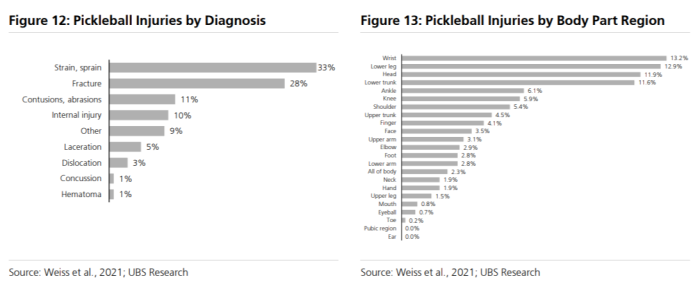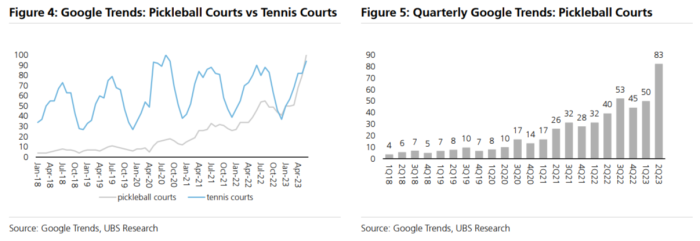Pickleball pandemonium
For too long Wall Street has remained silent about a threat stalking America’s seniors.
Now a team of brave UBS analysts is finally calling out this scourge of the sporting world, in a note titled: “Is Pickleball Driving Higher Health Care Utilisation”?
OK fine, in reality pickleball falls somewhere between an absurd public nuisance and a much-needed inclusive outdoor exercise.
Still, the UBS analysts’ note is based on one noteworthy fact: Americans who use Medicare (aged 65 and up) are apparently getting more outpatient surgeries, particularly for their hips and knees. UnitedHealth’s CFO discussed the trend at a Goldman Sachs conference this month. With our emphasis:
. . . outpatient levels have continued to be an area that we’ve really focused on most. . . leading indicators in two weeks of June [are showing] continued strong outpatient care activity.
Think things [like] hips, knees, and senior business. Hips, knees, cardio, very localised in Medicare businesses [are] where we’re particularly seeing the trend. There are some indications that looks a little bit like a pent-up demand or delayed demand being satisfied . . .
We have insight into other areas, for example, our ambulatory surgery practices that we own and operate, [we’re] seeing very strong volumes . . . So that has continued to be quite strong actually in terms of the care — at the levels of care activity that seniors are getting.
There are some obvious reasons for the recent increase in outpatient surgeries. Older Americans can now get surgery for non-life-threatening conditions that they put on hold during the Covid-19 pandemic, for example, as the UNH executive mentions above.
But blaming pickleball is a much funnier theory. From UBS, with our emphasis:
After analysing the growth in pickleball as well as the nature and frequency of related injuries, we conducted a bottom-up analysis of medical costs. All in, we estimate $250- 500 m of medical costs directly attributable to pickleball and see potential for greater medical costs indirectly linked to pickleball. Of this, we estimate that 80% of the cost is treated in outpatient settings (i.e. ED, Doctor Visits, OP surgeries) and 85% accrues to Medicare, which coincides with higher trend categories called out by UNH and HUM.
To be sure, $250m to $500m doesn’t look like much compared to the $800ish billion spent on Medicare parts A and B (tax-funded inpatient and outpatient care), the analysts point out.
Still, they deem it “plausible” that pickleball is contributing a noticeable amount to medical costs:
. . . we estimate that pickleball contributes 3-6 bps of annual Medicare medical costs. By care setting, we see about 6 bps of medical costs in the outpatient setting and 2 bps of medical costs in the inpatient setting. While this may seem trivial, it’s plausible that pickleball medical costs are driving 5-10 per cent of the unexpected medical cost trend this year.
Also, it’s maybe a stretch to estimate current-day pickleball injuries based on an academic study covering data from 2010-2019, the way the analysts do.
The game’s explosion in popularity has apparently happened in just the past few years, and trend stories portray pickleball as a sport that’s long been popular with retirees and just now catching on with the youth. A younger demographic probably experiences fewer injuries, and definitely won’t have access to Medicare when they do get injured.
That said, here’s more than you ever needed to know about seniors’ pickleball injuries, from UBS and the aforementioned study published in Injury Epidemiology in 2021:

The analysts also use historical Google Trends data to measure the increased popularity of pickleball. While the trend is clear, we don’t want to opine on whether or not this is an accurate reflection of interest from retirees. (Mostly on behalf of the 75-and-under crowd, many of whom seem more tech savvy than the seniors of yore.)

Still, it must have been tough for the analysts to speak out in this manner against the costs to society of Big Pickle.
Private equity has bought a stake, after all, and Hong-Kong listed Prada Group got a cut of the action; at one point it was selling a $2,500 pickleball accessory, as Lex highlighted.
So stay strong, UBS analysts. We’re rooting for you.
This story originally appeared on: Financial Times - Author:Alexandra Scaggs



























